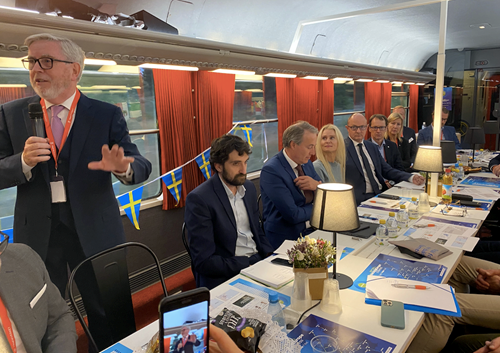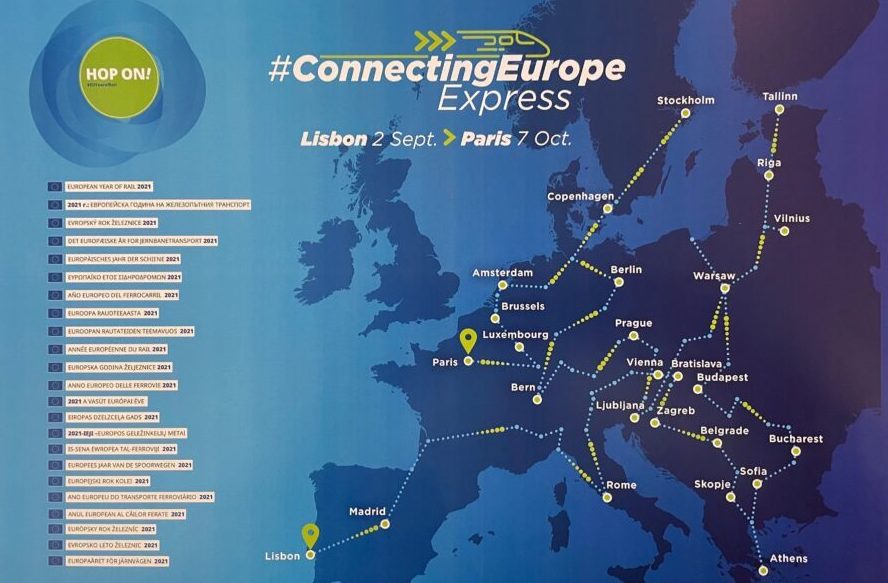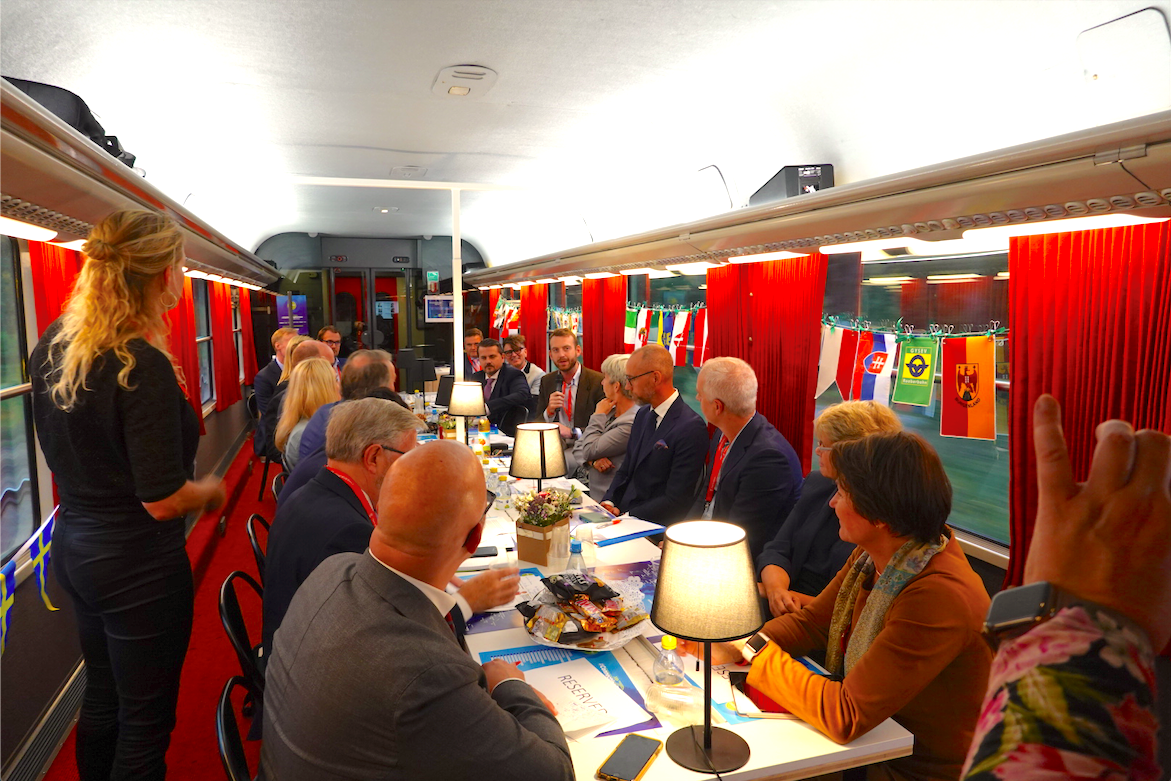Discussions about infrastructure in Northern Sweden onboard on the Connecting Europe Express

On the 1-2 October, the EU train Connecting Europe Express rolled through Sweden with high-level officials from the EU. The Swedish Bothnian Corridor collaboration participated and arranged seminars and meetings. Pat Cox, coordinator of the EU-Scandinavian-Mediterranean core network corridor, stated among other things that the Bothnian Corridor is a very important and strategic project that creates great European added value.
This year’s European Year of Rail, 2021, was highlighted through the Connecting Europe Express (CEE) train project, consisting of three trains that crossed through the entire EU from beginning September to beginning of October. One of the trains came to Sweden and on board were the coordinator of the EU-Scandinavian-Mediterranean core network corridor, Pat Cox, senior officials from the European Commission, members of the Swedish parliament, members of the European parliament and different representatives from business and the transport industry.

Clean industry in northern Sweden depends on green infrastructure
To highlight the importance of an expanded infrastructure in northern Sweden, the Bothnian Corridor collaboration arranged a seminar on board the train titled "What is the future of green industry without green infrastructure?". The Bothnian Corridor is a collaboration between the seven northernmost regions in Sweden and was represented on the train by members from the Bothnian Corridor's steering group. Also onboard in connection with the Bothnian Corridor was also other stakeholders from the regions involved in infrastructure.
For the northern regions, investments in infrastructure are core for the development due to the rapid green transition and enormous investments that are taking place in the north right now. Businesses in the north are making a historic transformation to become green, with planned investments of over 1,000 billion SEK (Swedish kronas) over the next 20 years. But the infrastructure to meet this development is still lacking. Without green infrastructure, there is a risk that the green products, such as the batteries from the Northvolt factory in Skellefteå, will have to be transported long distances in diesel-powered trucks instead of by rail and shipping. The EU's transport policy that was discussed on the train, aims precisely to bridge barriers at borders and connect the EU in an interconnected transport network.
A report was presented produced by New East coast line with the aim to analyze the future role of railways and shipping for transport of goods to and from northern Sweden - "The road towards transferring transport of goods to rail and shipping". Every year, the equivalent of 400,000 containers of goods goes on the roads between northern Sweden and Skåne and to then go out at sea. A large proportion of this volume of goods could be transferred from roads to shipping and rail transport when the New East Coast Line and the Norrbotnia Line are fully developed.
Great commitment to the Bothnian Corridor
By completing the construction of the Bothnian Corridor, a strong and cohesive route is created where heavy, long and fast trains can pass. It halves the industry's transport costs and increases competitiveness, and contributes greatly to the growing job market regions by halving travel times. It was a very good conversation on the train where, among other things, Pat Cox confirmed the image that there is a mutual dependence between the EU and Sweden as a member state. Among other things, concerning the need for transport of steel from Sweden to other parts of Europe.
- The Bothnian Corridor is a very important and strategic project that creates great European added value, Pat Cox said to sum up the discussions.
Jakop Dalunde, Member of the European Parliament, pointed out that Swedish industry is not only changing the work with steel in Sweden but could also change the whole of Europe's work in both the steel and battery areas.
- I think that we still underestimate this change in our steel industries, which could almost be described as a miracle when it comes to effects it has both on the economy and for the green transition. We should see this as a European project, concluded Jakop Dalunde.

Bothnian Corridor in focus during Swedish Televisions interview with Pat Cox
SVT also drew attention to Connecting Europe Express through an interview with Pat Cox just before the train went south from Stockholm to Brussels, where Cox focused on the work of the Bothnian Corridor collaboration to bring about an extension of the EU's main network corridor Scandinavia-Mediterranean to the north of Sweden, which became a reality this summer.
- The collaboration Bothnian Corridor has worked very actively for many years to sow a seed that has now taken root in our system so that the Bothnian Corridor is now part of the EU's core network corridor Scandinavian-Mediterranean, stated Pat Cox.
Cohesive planning is crucial to accelerate infrastructure development
A meeting was also held in the form of an in-depth follow-up of Friday's talks in which MEP Johan Danielsson participated together with Pat Cox and Morten Jensen, unit manager at CINEA - The European Climate, Infrastructure and Environment Executive Agency. CINEA has an important role in the work of implementing the green deal with a climate-neutral Europe 2050 as a goal and is responsible for, among other things, the financing tool CEF - Connecting Europe Facility - from which the EU has invested SEK 250 million in Sweden this year. Of this year's decided five projects in Sweden, four are in the geography of the Bothnian Corridor.
- When Sweden is allocated CEF funds, it is important that these are placed on top of the existing infrastructure budget and lead to new projects being financed within the framework of the national plan. In this way, EU funding would really mean that the expansion of infrastructure is accelerated, said Johan Danielsson.
- It is important that Sweden points out the Bothnian Corridor as a coherent route and calculates all the societal benefits from the entire route and not only look to the benefits of each sub-route in an isolated way, Lotta Rönström from North Sweden European Office pointed out.
In addition to funding issues, the discussion also dealt with the ongoing revision of the regulation for the trans-European transport network, TEN-T, where the Bothnian Corridor is working to increase the number of designated urban nodes, terminals and ports in the transport system in Sweden.
Read the Bothnian Corridor's position paper on TEN-T here.
Read about the North Bothnia line in the Bothnian Corridor here.
Read more about the New East Coast line here.
/Lotta Rönström
